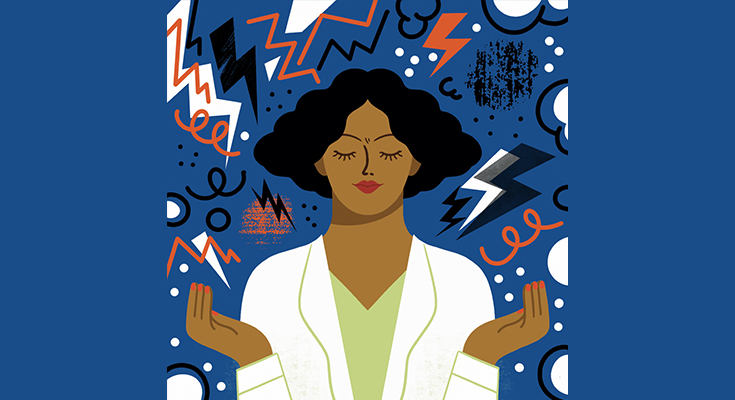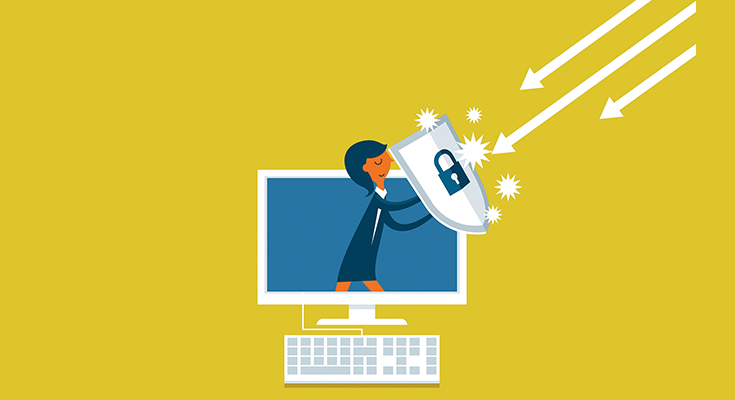
Illustration by Veronica Grech
By Harsh Grewal
It’s hard not to get emotionally worked up when a conversation with a patient is going off the rails.
When Dr. James Goertzen feels himself becoming rattled during an interaction with a patient, he allows himself the opportunity to pause. Those 30 seconds allow him to recentre the conversation and become intentional in his response, instead of emotional.
The more time you give yourself to process your emotions, the less intense they are likely to be, he says. By taking that moment to disengage and take a deep breath, he is able to identify what he is feeling, put his ego aside, see the person in front of him more clearly and realign the conversation toward a more favourable outcome. Essentially, he says, the pause provides him the ability to respond instead of react.
The more time you give yourself to process your emotions, the less intense they are likely to be.
Dr. Goertzen, a family physician and Associate Dean, Continuing Education and Professional Development (CEPD) at NOSM University, was sharing his experience as a panelist during a webinar entitled, “Navigating Stressful Interactions with Patients and Other Providers,” part of the Ontario College of Family Physicians’ Practising Well self-learning program.
As all the panelists in the webinar made clear, communication is a critical skill for a physician, but it isn’t always easy — especially under the constraints of an under-resourced, overstretched system. As a result, physicians often find themselves facing stressful interactions with patients that demand, in addition to clinical acumen, profound compassion and understanding.
Amidst the backdrop of life-changing diagnoses, unexpected complications and the uncertainty accompanying illness, patients may display a myriad of emotions — fear, anger, frustration or vulnerability — which can sometimes manifest as difficult behaviour. Coupled with the pressures of a demanding work environment, health care professionals face the arduous task of understanding their patients’ perspectives and delivering compassionate care, all while managing their own emotions.
A common source of patient unhappiness — especially since the pandemic — is delays in seeing a specialist. When patients complain about the long wait to receive care, Dr. Joan Chan, a Guelph family physician, says she aims to be empathetic. She understands the patient’s complaint is often based in fear about their health. Relating to them as a fellow human rather than an authority figure can create an avenue of connection with the patient, she says.
Pandemics, long wait times and even patient expectations are all beyond the physician’s control, Dr. Chan reminds the audience. “I think we’re all really socially conditioned to believe we’re responsible for things that are outside of our control, and a lot of our stress and burnout comes from that,” she says. Put your energy into what you can control, she suggests, like your response to patient disappointment and expectations.
“I think we’re all really socially conditioned to believe we’re responsible for things that are outside of our control, and a lot of our stress and burnout comes from that”
Dr. Chan recommends physicians set flexible boundaries and build a menu of what they are willing to offer when dealing with difficult or demanding patients. For her clinic, she developed a “Patient Rights and Responsibilities” document, which outlines the rights of her patients, such as receiving quality care in a timely fashion, being treated with courtesy and respect, and participating in making treatment decisions, including the refusal of care. Among the listed responsibilities of patients, she asks them to be an active participant in their care, asking questions and expressing concerns, providing accurate information about their medical history, and being courteous and respectful to staff.
Dr. Claudia Hubbes, family physician and Assistant Professor in the Department of Family Medicine at the University of Ottawa, told the webinar audience that burnout is significantly higher among women physicians. The CMA National Physician Health Survey found 59 percent of women experienced burnout, compared to 43 percent of men.
“The reason it seems to affect female physicians disproportionately, I think, is because we tend to also have extra stuff that we do at home. The unpaid emotional burden that we talked about — the childcare, taking care of home and also aging parents,” she says.
In terms of coping strategies, Dr. Hubbes encourages physicians to find ways to prioritize self-care and engage in practices that help alleviate burnout, such as setting boundaries and recognizing when patients’ demands are beyond the physician’s control.





